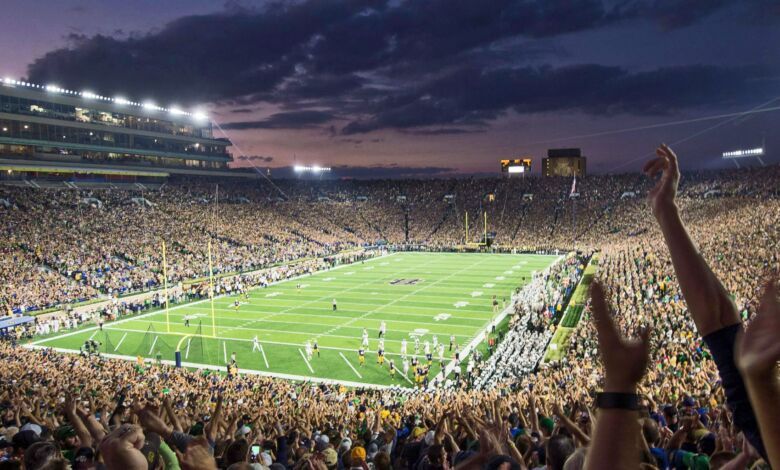
Notre Dame Stadium, also known as the House that Rock Built, has been the home of the Fighting Irish of Notre Dame since it was constructed in 1930. Since then the stadium has undergone a major renovation in 1997, but to this day, it is still has remained true to its old school roots. Void of Jumbotrons, corporate sponsors, or even fancy end zone designs, Notre Dame Stadium is a model of traditional collegiate athletics and is consistently ranked as one of the most historic stadiums in college football.
The simple, yet classic design of Notre Dame Stadium makes it unique in the age of Jumbotrons plastered with corporate logos. Even the end zones of Notre Dame Stadium are simple in their design with each featuring only ten diagonal hashmarks and nothing else. The midfield of Notre Dame Stadium is also absent of any giant team logos or decorations.
The most unique feature of the stadium, however, is the view of the legendary “Touchdown Jesus” mural painted on the Notre Dame library. The renovation in 1997 blocked most of the view, but a part of the famous painting is still viewable from inside the stadium.
Notre Dame Stadium Facts
Original Construction and Early History
Before the Construction of Notre Dame Stadium, the Irish called the 30,000 seat Cartier Field home. Knute Rockne, who had taken Notre Dame to the top of the college football world with national titles in 1924 and 1929, was able to get a larger stadium approved by the University and in April of 1930 construction began on the larger 54,000 capacity Notre Dame Stadium.
Rockne, impressed by Michigan’s massive stadium, had Notre Dame Stadium designed based off the Big House only on a smaller scale with a construction cost of $750,000. Rockne’s fingerprints are all over the stadium as he had a say in almost every aspect of the stadium including reducing the distance between the field and the stands to reduce the number of sideline guests during games. Rockne was also heavily involved in designing the parking and traffic patterns for the original stadium.
The Osborn Engineering Company won the bid to build the stadium in 1929. Yankee Stadium, The Polo Grounds, Comisky Park, and Michigan Stadium were also designed by the Osborn Engineering Company.
Upon completion of construction in 1930, Notre Dame Stadium had a perimeter of half a mile and stood 45 feet above ground. The original press box had enough room for 264 writers as well as room for photographers and broad casters.
The first game in the stadium was held on October 4, 1930 when Southern Methodist (SMU) made the trip from Texas to Indiana to open what would be Knute Rockne’s last season at Notre Dame and his only as head coach in the new Notre Dame Stadium. The Irish won the game 20-14, the first of 10 wins in an undefeated season which netted Rockne his third national championship. A week later, the Midshipmen of Navy made their first appearance in Notre Dame Stadium for the official dedication of the new home of the Fighting Irish. Neither game, however, was seen be a capacity crowd. That distinction would occur until the following season with Southern Cal’s first contest in Notre Dame Stadium was seen by a capacity crowd of 50,731.
Expansion and Rededication
In May of 1994, the Notre Dame Board of Trustees approved a 21,000+ seat expansion and modernization of Notre Dame Stadium. The expansion, proposed to the Board a year earlier by University President Rev. Edward Malloy, increased the capacity of the stadium from 59,075 to 80,795 and began almost immediately following the completion of the 1995 season.
Twenty –one months later, the massive construction project was complete and Notre Dame Stadium went from the 15th biggest in college football to the 8th. On top of the addition of 21,000+ seats, the project included expanding the press box to include space for 330 reporters as well as adding additional space for television and radio broadcast booths. Two new scoreboards along with new field and drainage systems were also added the stadium.
Both the home and away locker-rooms were double in sized as part of the expansion while the home locker-room served as a permanent home for the Irish players for games and practices prior to the construction of “the Gug” in 2005.
Notre Dame opened its newly expanded stadium with a new coach in September of 1997 against Georgia Tech in Bob Davie’s first game as the head coach for the Irish. Notre Dame held on to a 17-10 victory over the visiting Yellow Jackets to celebrate the Rededication with a win.
Night Games & Music in Notre Dame Stadium
Night games were not played inside Notre Dame Stadium from 1990 until 2011. Notre Dame changed that policy with USC’s trip to South Bend on October 22, 2011. The Irish and Trojans played under the lights of Notre Dame Stadium for the first time since Michigan’s visit.
That game also marked another change in policy for Notre Dame. Previously the only sounds to be heard in the stadium came from either the Notre Dame Marching Band, the oppositions band, or the public address announcer. Starting with that game, however, music was introduced into the game day experience. Music selection that night left a lot to be desired with Ozzy Osborne’s “Crazy Train” being blared over and over and over again, but has since improved.
The 2011 night game experiment was a huge success and every year since, Notre Dame has played at least one home night game. In recent seasons, Notre Dame has added multiple home night games. In 2015, both the Texas and USC games were under the lights and the Michigan State and Stanford games were as well a year later. In 2017, Notre Dame will host both Georgia and USC in prime time inside of Rock’s House.
Campus Crossroads Project
In January 2014, Notre Dame announced a massive renovation project for Notre Dame Stadium called “The Campus Crossroads Project.” The $400 million project aimed to modernize Notre Dame Stadium and allow for greater use of the stadium outside of football Saturdays in the fall.
Construction began in 2014 and is scheduled to be completed for the 2017 Notre Dame football season opener against Temple. As part of the project, three new buildings were built around the stadium and retrofitted into the current structure. These buildings will be used primarily for academic purposes which created 80 new full time faculty positions at the University.
Football specific enhancements in this project include a complete renovation of the Notre Dame locker room and a new visitor specific entrance to the field. Once complete, Notre Dame will no longer share their entrance to the field with the opposition.
The gameday atmosphere will be enhanced through the installation of cell boosters to enhcnace the wifi capabilities within the stadium. Gone will be the days of your phone searching for signal for 3+ hours and being unable to communicate with anyone in the stadium you are trying to meet with.
Notre Dame Stadium Installs FieldTurf
In April 2014, nearly four months after the announcement of the Campus Crossroads Project, Notre Dame announced that they would be installing FieldTurf for the 2014 season. For the entire history of the Notre Dame Stadium up until that point, a natural grass field surface was used.
In the years leading up to the announcement to install FieldTurf, the playing surface inside the stadium deteriorated greatly throughout the seasons. By the time Senior Day rolled around in previous seasons the field featured an unacceptable amount of dead, brown turf.
The first game to played on the new artificial surface was the 2014 season opener against Rice. Notre Dame won the contest 48-17. The following week Michigan visited Notre Dame for the first time since the installation. The Irish went on to shutout the Wolverines 31-0. It was the first shutout of Michigan by Notre Dame and really the FieldTurf had no baring on the outcome but it is always a good time to mention that game.
Notre Dame (Finally) Gets a Jumbotron
Ever since the announcement of the Campus Crossroads project it was very clear that Jumbotrons were coming to Notre Dame Stadium much to the chagrin of the old guard Notre Dame fans. It wasn’t until August 2015 – more than a year and a half after the project was announced – that Notre Dame confirmed it would be installing a Jumbotron in the stadium.
The new “video board” will be in the South endzone and will be functional for the 2017 season opener. Notre Dame has said throughout the Campus Crossroads Project that there will still not be any advertising inside Notre Dame Stadium.
In addition to the new Jumbotron, the sound system in the stadium will also be upgraded for the 2017 season. Ever since the introduction of music into the Notre Dame game day experience, enhancements were needed to the sound system.
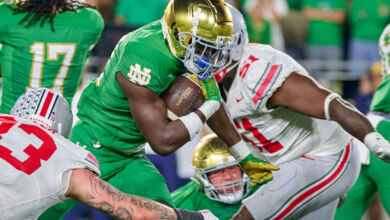
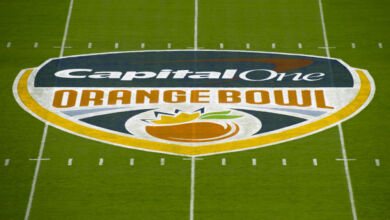
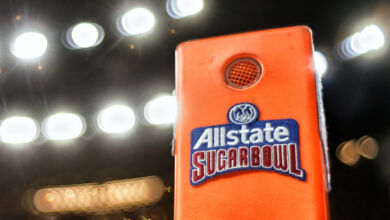
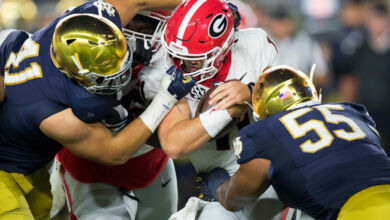
“Touchdown Jesus”, officially named “The Word Of Life” is not a painting. It is a mosaic of thousands of different and colored stones.
And the renovation did not “hide” the mosaic. It has always only been visible from the upper sections of the south endzone and sides of the stadium. It was never visible from the field.
Interesting, to me, jealously-inciting to those who live to depart of records; but a little did-bit that might make others, well, jealous. I was part of the class of 1989. Members of my class were potentially part of 2 of the above Notre Dame Stadium-records. 1) Most combined points (vs. SMU in Fall, 1986, Lou’s first year when we were Sophs) and 2) Most wins in on season. (7 in 1988, year of most recent Natty)